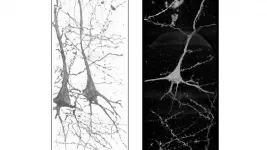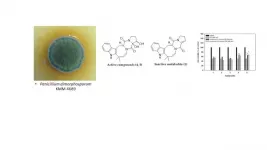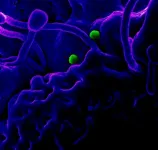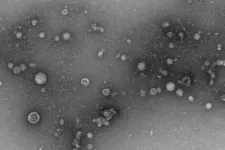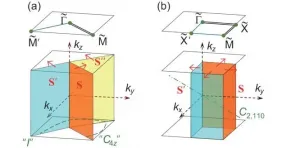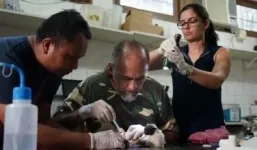(Press-News.org) Neuroblastoma is a cancer that develops in nerve tissue, most commonly in the glands around the kidneys. The gene MYCN is overexpressed in 20-25% of neuroblastoma, and MYCN-amplified neuroblastoma contributes to a considerable percentage of pediatric cancer-related deaths.
Anthony Faber, Ph.D., and a team of researchers at VCU Massey Cancer Center were awarded a grant from the American Cancer Society to study how MYCN and an abundance of iron can drive cancer cell death in neuroblastoma and potentially be targeted with novel treatments. This award is the first part of a potential two-stage grant worth a combined total of $600,000.
"Iron is a double-edged sword in a cancer cell. It can help the cancer grow and survive, but it also creates these toxic molecules within the cell called reactive oxygen species," said Faber, Natalie N. and John R. Congdon Chair in Cancer Research and co-leader of the Developmental Therapeutics research program at Massey and associate professor in the Philips Institute for Oral Health Research at the VCU School of Dentistry.
Reactive oxygen species (ROS) are highly unstable chemical molecules that react with other molecules within a cell and cause damage to genes and cell death (ferroptosis). Ferroptosis is a recently discovered type of cell death that is largely influenced by the accumulation of iron. Faber said there is a relatively small scientific understanding of ferroptosis, and even less is known about which cancers may be prone to ferroptosis-inducing drugs.
Through recent research published in Cancer Research, Faber and his collaborators have determined that the MYCN gene creates a vulnerability to drugs that induce ferroptosis because MYCN uses a lot of iron to help power the cancer cell and grow uncontrollably.
By ramping up the systems that remove toxins on a cellular level, MYCN generates so much iron that it also initiates a weakness to drugs that block the ability of the cell to eliminate ROS, as discovered by Konstantinos Floros, Ph.D., postdoctoral fellow at Massey and the Philips Institute for Oral Health Research whose extensive background in cell death effectively advanced this research project.
The researchers found that blocking these detoxifying systems with available drugs makes MYCN-amplified cells sick and die.
"As MYCN continues to be one of the most important targets in cancer therapeutics, this study highlights a new and clinically important strategy for treating MYCN-associated cancers," Faber said.
Using preclinical tumor models, Faber's team will use the grant funding to test the ability of sulfasalazine and auronofin - drugs FDA-approved for rheumatoid arthritis - to induce ferroptosis and tumor responses in neuroblastoma cells with high levels of MYCN.
"Fortunately, the Cancer Mouse Models Core run by Jennifer Koblinski, Ph.D., and Bin Hu, Ph.D., at Massey is spectacular and will allow us to robustly test these FDA-approved drugs in both patient-derived models and orthotopic models, where the tumors grow atop the adrenal glands similar to the way they grow in patients," Faber said.
Faber said that if they show positive results testing these drugs in cancer models, then they can confidently test these therapies in clinical trials.
"This Mission Boost Grant from the American Cancer Society allows us to conduct one of the earliest studies to link a cancer-driving gene to ferroptosis," Faber said. "This is a significantly important field of study that may have far-reaching implications in cancers beyond neuroblastoma, including some small cell lung cancers and triple negative breast cancer, which rely on a similar protein (c-MYC) to drive their growth."
INFORMATION:
Faber and Floros' collaborators on the Cancer Research study and ongoing grant funding project include Koblinski and Mikhail Dozmorov, Ph.D., members of the Cancer Biology research program at Massey; Sosipatros Boikos, M.D., member of the Developmental Therapeutics research program at Massey; Benjamin Belvin Ph.D., Carter Fairchild, Colin Coon, Janina Lewis, Ph.D., JingYang Cai Ph.D., Krista Powell M.S., Richard Kurupi and Sheeba Jacob Ph.D., of the VCU Phillips Institute for Oral Health Research; Hu, Madhavi Puchalapalli, M.S., and Mayuri Shende, of the Department of Pathology at the VCU School of Medicine and Massey; Kimberly Swift and Sivapriya Ramamoorthy, Ph.D., of Metabolon, Inc.; and John Glod, M.D., Ph.D., of the NCI Pediatric Oncology Branch.
Schizophrenia, a chronic, neurological brain disorder, affects millions of people around the world. It causes a fracture between a person's thoughts, feelings and behavior. Symptoms include delusions, hallucinations, difficulty processing thoughts and an overall lack of motivation. Schizophrenia patients have a higher suicide rate and more health problems than the general population, and a lower life expectancy.
There is no cure for schizophrenia, but the key to treating it more effectively is to better understand how it arises. And that, according to Ryuta Mizutani, professor of applied biochemistry at Tokai University in Japan, means studying the structure of brain tissue. Specifically, it means comparing the brain tissues of schizophrenia patients with those ...
Even as more people are logging onto popular video chat platforms to connect with colleagues, family and friends during the COVID-19 pandemic, Stanford researchers have a warning for you: Those video calls are likely tiring you out.
Prompted by the recent boom in videoconferencing, communication Professor Jeremy Bailenson, founding director of the Stanford Virtual Human Interaction Lab (VHIL), examined the psychological consequences of spending hours per day on these platforms. Just as "Googling" is something akin to any web search, the term "Zooming" has become ubiquitous and a generic verb to replace videoconferencing. Virtual meetings have skyrocketed, with hundreds of millions happening daily, as social distancing protocols have kept people apart physically.
In ...
Biologically active compounds from the marine fungus Penicillium dimorphosporum protect cells from paraquat, the highly toxic herbicide with no remedy, and might enhance the action of some drugs. The fungus was isolated from soft coral collected in the South China Sea during an expedition on the Akademik Oparin research vessel. Scientists of Far Eastern Federal University (FEFU) and G. B. Elyakov Pacific Institute of Bioorganic Chemistry reported the results in Marine Drugs.
Paraquat a herbicide compound highly toxic for animals and humans. About a hundred countries, including the United States, apply it for crop cultivation and weed control. Dozens of countries, including Russia, have banned the ...
A new research study out of the University of Nevada, Reno's School of Community Health Sciences has just been published by the American Journal of Public Health and addresses state preemption of local sugar-sweetened beverage (SSB) taxes, issuing an emerging public health threat. Assistant Professor Eric Crosbie examines commercial determinants of health and public health policy, specifically in industries like tobacco and food and beverage.
"The beverage industry is aggressively attempting to preempt sugar-sweetened beverage taxes at the state level to prevent the diffusion of progressive policies at the local level throughout the United States," Crosbie, an affiliate of the University's Ozmen Institute for Global Studies, said. "Once preemption laws are enacted, ...
There is growing evidence that ketone bodies may be beneficial to heart disease patients regardless of the method of delivery used to increase ketone delivery to the heart. A Journal of the American College of Cardiology review paper examines emerging evidence regarding ketone bodies' effects on the heart and the potential for ketone therapy as a cardiovascular intervention in heart disease patients.
In recent years ketone bodies entered the popular lexicon through the "keto diet," which consists of a very low carbohydrate and high fat diet that endeavors to force the body into ketosis. This is a metabolic ...
WHAT:
A randomized, placebo-controlled Phase 1 clinical trial of two monoclonal antibodies (mAbs) directed against the coronavirus that causes Middle East respiratory syndrome (MERS) found that they were well tolerated and generally safe when administered simultaneously to healthy adults. The experimental mAbs, REGN3048 and REGN3051, target the MERS coronavirus (MERS CoV) spike protein used by the virus to attach to and infect target cells. The mAbs were discovered and developed by scientists at the biopharmaceutical company Regeneron, located in Tarrytown, New York. The trial was sponsored by the National Institute of Allergy and Infectious Diseases (NIAID), part of the National Institutes of Health.
The trial was the first to test the experimental antibodies
Hyperlink Code ...
Inflammatory lung diseases such as asthma, COPD and, most recently, COVID-19, have proven difficult to treat. Current therapies reduce symptoms and do little to stop such diseases from continuing to damage the lungs. Much research into treating chronic inflammatory diseases has focused on blocking chemicals called cytokines, which trigger cascades of molecular events that fuel damaging inflammation.
Now, scientists at Washington University School of Medicine in St. Louis have found that such cytokines can drive inflammation in more ways than previously understood, perhaps revealing new routes ...
Using the symmetries of the systems, people can define various topological invariants to describe different topological states. The topological materials can be accurately discovered by calculating the topological invariants. Recently, researchers found that irreducible representations and compatibility relationships can be used to determine whether a material is topological nontrivial/trivial insulator (satisfying the compatibility relations) or topological semimetal (violating the compatibility relations), which leads to a large number of topological materials predicted by theoretical calculations. However, Weyl semimetals go beyond this paradigm because the existence of Weyl fermions does not need any symmetry protections (except for lattice translation symmetries). At present, ...
Urban areas are on the rise and changing rapidly in form and function, with spillover effects on virtually all areas of the Earth. The UN estimates that by 2050, 68% of the world's population will reside in urban areas. In the inaugural issue of npj Urban Sustainability, a new Nature Partner Journal out today, a team of leading urban ecologists outlines a practical checklist to guide interventions, strategies, and research that better position urban systems to meet urgent sustainability goals.
Co-author Steward Pickett of Cary Institute of Ecosystem Studies explains, "Urban areas shape demographics, ...
By Maria Fernanda Ziegler | Agência FAPESP – Yellow fever was the first human disease to have a licensed vaccine and has long been considered important to an understanding of how epidemics happen and should be combated. It was introduced to the Americas in the seventeenth century, and high death rates have resulted from successive outbreaks since then. Epidemics of yellow fever were associated with the slave trade, the US gold rush and settlement of the Old West, the Haitian Revolution, and construction of the Panama Canal, to cite only a few examples.
Centuries after the disease was first reported in the Americas, an international team of researchers will embark on a groundbreaking study to develop ...

